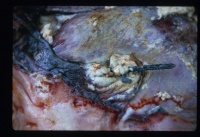Traumatic Pericarditis
Also known as: Wire — Hardware Disease
Also see: Traumatic Reticulitis — Pericarditis
Introduction
This heart condition is a common cause of severe abdominal pain in cattle, predominantly dairy cattle. It is very rare in other animals. It is caused by ingestion of wire or other piece of metal into the rumen of the cow. Ruminal movements can cause the wire to penetrate the cranial reticulum and therefore penetrate the pericardium and/or liver causing pericarditis.
Clinical Signs
The animal will usually appear dull and depressed and may stand away from the herd. She will often show extension of the neck, arching of the back and stand with elbows abducted, which are all signs of cranial abdominal discomfort. There will often also be signs of right sided heart failure and peripheral oedema.
Diagnosis
History and clinical signs may be indicative of the disease. On physical exam, the cow will elicit a grunt (pain response) when pressure is applied to the ventral abdomen. She will often be pyrexic, have increased pulses and decreased rumen sounds. The faeces may be dry and mucus covered and there will be a noticeable tachycardia. On auscultation of the heart, initially friction rubs or 'Squeaks' may be heard indicating pericardial or pleural adhesions. These may then progress to 'whooshing' sounds over the heart, indicating presence of fluid in the pericardium.
Blood tests may show a neutrophilia with a left shift, increased fibrinogen and increased serum total protein.
Fluid analysis of fluid from the pericardium will confirm traumatic pericarditis, by showing presence of bacteria within neutrophils as well as a large number of degenerate neutrophils.
Treatment
Confine the animal to prevent stress from the rest of the herd. Administer broad spectrum antibiotics immediately. A rumenotomy should be performed and a hand guided down into the cranial rumen or reticulum to find and remove the foreign object. However, although these treatment options are all viable, the animal is usually culled on economic grounds in most cases.
Prevention through good husbandry practices, such as a magnet in the feeding wagon etc, is the best control measure.
| Traumatic Pericarditis Learning Resources | |
|---|---|
 Test your knowledge using flashcard type questions |
Cytology Q&A 16 |
References
Andrews, A.H, Blowey, R.W, Boyd, H and Eddy, R.G. (2004) Bovine Medicine (Second edition), Blackwell Publishing
Ather, H, Parrah, J.D, Moulvi, B.A, Singh, M, Dedmari, F.H. (2012) Pericarditis in Bovines - A ReviewInternational Journal of Advanced Veterinary Science and Technology
Divers, T.J. and Peek, S.F. (2008) Rebhun's diseases of dairy cattle Elsevier Health Scieneces
Radostits, O.M, Arundel, J.H, and Gay, C.C. (2000) Veterinary Medicine: a textbook of the diseases of cattle, sheep, pigs, goats and horses Elsevier Health Sciences
| This article has been peer reviewed but is awaiting expert review. If you would like to help with this, please see more information about expert reviewing. |
Webinars
Failed to load RSS feed from https://www.thewebinarvet.com/cardiology/webinars/feed: Error parsing XML for RSS

